Findings |
Analysis |
- Students learnt difficult vocabulary and abstract concepts about dinosaurs and their extinction.
- Teachers used examples to explain the concept of collocation in context.
|
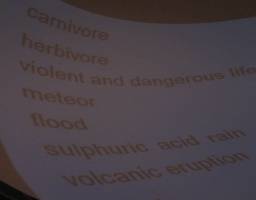
High level vocabulary for primary students:
carnivore, herbivore, violent and dangerous life, meteor, flood, sulphuric acid rain, volcanic eruption, extinct
|
- Teachers used questions to probe students to give more details. Through the process, students realized that the death of the dinosaurs was not caused by a meteor directly.
- Instead of giving general points and jumping to conclusions, students started to think more carefully about the fundamental cause of a phenomenon.
|
T: How did the dinosaur die?
Students’ answers
- Flooding
- Volcanic eruption
- A meteor crushed the Earth
T: We called these ‘natural disasters’.
T: How did the dinosaurs die?
S: A meteor crushed the earth.
T: Did that by itself kill the dinosaurs?
Students’ answers
- dust covered the sky
- it became cold
- ice age
- there was no sunlight
- the plants were killed
- plant-eating dinosaurs could not eat the plants and died
|
Some students knew a lot about dinosaurs and were able to answer the 3 questions about the life of dinosaurs and their extinction in EC Lesson. |
-
This showed that although this topic might be perceived as too sophisticated for primary students, those who liked the topic had done a lot of reading on it without being asked to.
|
|
A few students in each class were able to answer the three questions without much preparation. |
- Students did research and reading on the extinction of dinosaurs after the lesson.
- Motivated or high ability students were able to pick up unfamiliar topics in a short period of time. They have self- learning skills to equip themselves.
Their self-learning skills are well-developed and they can learn independently.
|
More students were able to share their ideas on the 3 questions on EC lesson
2. They were more familiar with the topic.
 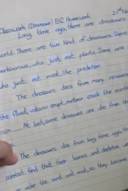 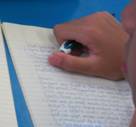
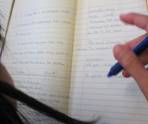 
|
- When developing students’ creativity, written text provided more room than video. One class was shown the simulation video. Many students in this class said that those were the bones of a woman because that was shown in the video. The video had distorted their imagination / misled them.
- When answering open ended questions, students could come up with many different ideas. Some were creative. They had to imagine what happened, why it had happened and who was involved, and constructed a crime story.
|
EC Lesson 2: Bones under bathtub
Whose bones are those?
- Woman
- Man (master of the house)
- Died for a long time
- Neighbours
- Friends
- Family
- Neighbour
- Pig bones from the soup
Why were there bones? What happened?
- The master killed his friend/ family members.
- A man killed a woman. The woman knew something which the man did not want her to tell.
- Someone killed a person and hid the bones under the bathtub.
How should we start the investigation? (Who to ask? What to read? What to do?)
- Ask the neighbours as they should have heard some noise the killer killed the family member and they would smell some smelly smell a long time after (s)he was killed.
- Check the fingerprints.
- Check if there is blood stains in the bathroom because the bones were found there. The person might have been killed there.
|
- The task was motivating as the incident took place in the school campus. They were curious about what the construction workers said and the two photos.
- It was amazing that some students said those were the bones of other creatures rather than dinosaurs. They made their points by estimating the size (too small for a dinosaur) and using their background knowledge (a girl connected the bones to the Komodo dragons which she had learnt about through reading and watching a documentary). Some thought the bones were fake because it was not reported by the media and the bones were too white and clean, so a skeleton dug up from the ground should be covered in mud. Students thought that people put fake bones there because they wanted to play a trick. A student thought that the worker had sent the video and photos to the school because he wanted to blackmail the school.
- Collaborative learning took place during the lessons. Students worked together to construct stories about what had happened in the school campus.
- Teachers accepted all the answers which students were able to justify. This motivated students to add details to the ideas.
- When talking about why there were bones and what had happened, some students were able to refer to the history of Shatin (It was part of the sea) or life in ancient times (hunting)
- When talking about investigation, most of them knew that they had to consult the experts. Teachers probed them to give details of the experts instead of just giving answers like “professors”. Teachers asked them where these experts worked and which fields were these experts in.
- Some students mentioned CSI and DNA. These students were probably influenced by crime or detective stories/ movies/ TV series.
- Some students suggested asking the construction workers. This was a very general point. Teachers asked questions to help students elaborate their ideas by thinking about how to look for these workers. Students jumped to the solution – asking the principal. The principal was new to the school. The teacher asked the students if they thought this principal knew who these workers were. Some students suggested calling the former principal to ask if she knew what had happened or how to look for the workers.
- Some students suggested searching information on the net. Teachers probed students to give specific information about what to look for and which websites to look at (reliable ones).
|
EC Lesson 3: A mail from a construction worker
Whose bones are those?
- Dinosaurs
- Animals
- Long time ago there were some dinosaurs and somebody saw them and killed them and then the skeleton was buried under the ground.
- An animal bitten by some huge animal
- A huge crocodile (dinosaur is bigger than the school)
- Fake bones (it is white and clean, skeleton in mud can’t be like that; use some white paint to draw on the soil)
- Animal in the world which scientist not yet found
- Big lizard never found by people
- Alligator
- Komodo dragon
- Aliens
- Big monsters
- A puzzle, a trick set up by secondary school students
- 3D paintings
Why were there bones? What happened?
- There was a river, the dinosaurs came to drink water.
- People from ancient time hunt the animal and forgot to eat it. After thousands of years, it becomes fossils.
- A dinosaur ate another dinosaur.
- Maybe someone from Komodo Island brought the Komodo dragon to Shatin because Shatin was a farmland before and it died.
- Maybe the worker who sent the information to the school tried to play a trick on the school because he was angry. He wanted money.
- There was no food in school.
How should we start the investigation? (Who to ask? What to read? What to do?)
- Invite professor of HK History Museum to find out what it is.
- Ask police and CSI officers to check the DNA of the dinosaur and we would know what kind of animal it was.
- Contact DNA professor in the university to find out the DNA in the bones.
- Put on newspaper to let Hong Kong people know what is happening.
- Gather all workers’ names and ask them who sent these.
- Ask Dr. Tang, our previous principal to see if she had information about the construction workers or if she knew there were bones under the planetarium.
- Search information on the net about fossils, search for pictures to see if the fossils are real.
- Ask the worker who took the picture.
- Invite professor of HK History to explain what the purpose of the planetarium was when it was built 10 years ago (History of the place).
- Check the construction company.
- Search reliable websites (e.g. Ming Pao, SCMP, National Geographic magazine, National History Museum) on the internet.
|
- All the points contributed by students were accepted. Listening to students and encouraging them express their ideas facilitated effective classroom discussion.
- By asking open-ended questions which probe students to contribute ideas, elaborate and clarify points, students were able to come up with more sophisticated answers.
- Interactions between teachers and students and students and students took place in class. The teachers were not the only ones to comment on the students points. It was the students themselves who evaluated the points given by the others.
- In this 5 minute section, 11 students were involved. They all made contributions.
|


|
- Gifted students were identified. S1 is a creative student. S9 gave good points although his language proficiency was poor. He knew a lot about dinosaurs – living habits and DNA. These students need to be challenged further.
- Some answers were not expected by teachers. Students knew more than teachers expected (S2).
- Interaction between students was fostered (S3 asking S2 to explain her point; S4 assisting S2 to express her idea; S3 evaluating S8’s idea, S8 refine his idea based on S3’s comment). The discourse showed that students involved in the conversation were all engaged in the discussion. All of them participated actively either by being a listener or contributor.
- Creative points were fun. Whenever a creative point was given, a lot of students laughed.
- Not all students were talented in using language to express their ideas and yet, they all had ideas and some were brilliant and creative ones (like S7). The environment allowed students to express their ideas in a free and relaxed way. The teachers rephrased and reconstructed the ideas together thereby helping students improve their language skills.
- Student (S7) evaluated the teacher’s idea. This took place because the learning environment was supportive and encouraging.
|
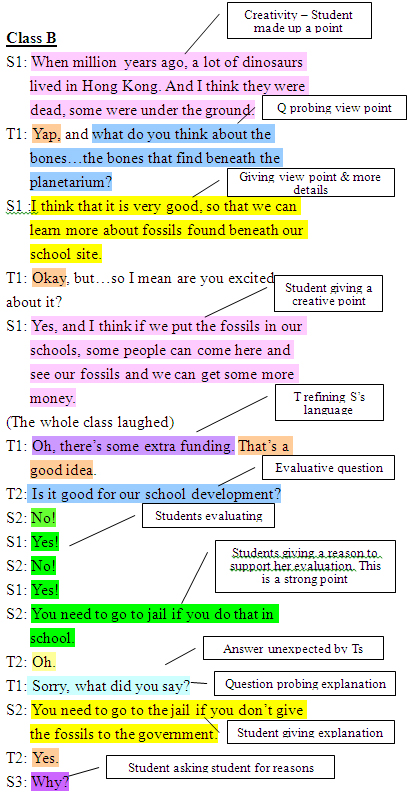

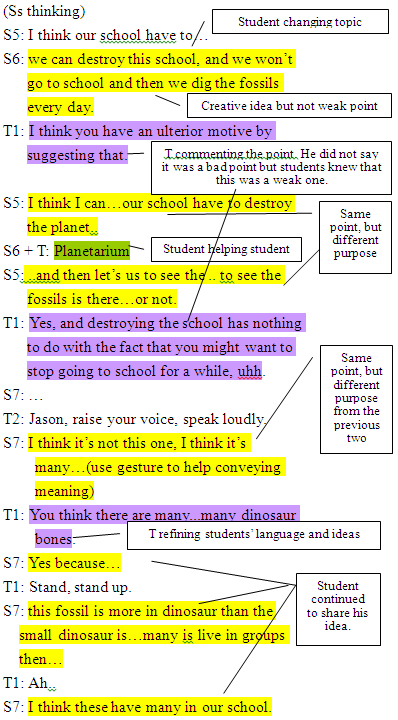
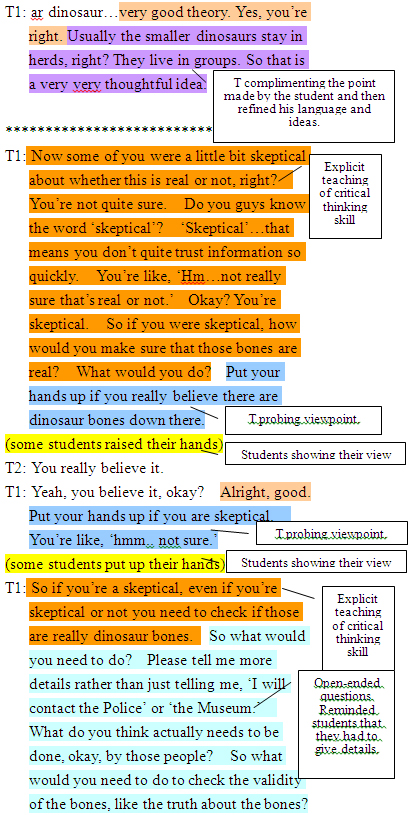
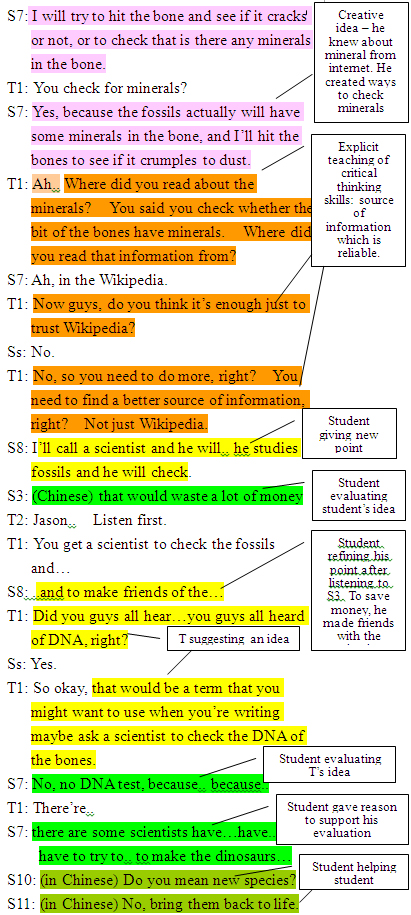

|

